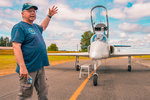
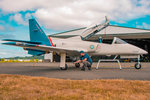
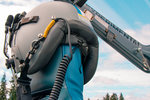
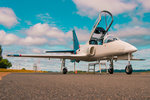
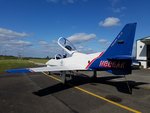


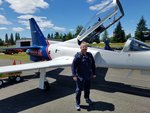
David Thomas started building radio-controlled model airplanes when he was 8 years old. His love of planes never faded and after obtaining his pilot’s license in 1997, Thomas decided to buy a kit to build a ViperJet MK II in 2002 — “the sports car of planes,” as he called it. The building and the testing process took Thomas 18 years and 12,000 build hours to complete.
“It’s kind of interesting because people said I would never get it finished. You know how people are — they said it would never fly. We did finish it and it has flown. It was a long process and my wife is glad that it’s done,” Thomas said.
The ViperJet is currently being held at the Chehalis-Centralia Airport, where it has undergone various flight tests. The ViperJet’s first flight was from Puyallup to the Chehalis-Centralia Airport in 2017 — where the plane has undergone several flight tests since then. The plane is a two-passenger jet that has been tested at 450 miles per hour at 17,500 feet.
“Flying it is quite a thrill. When you’re up there in that bubble canopy you can just see all over the place. It’s just amazing the view you have. It goes fast so it lands a little bit faster than normal planes,” Thomas said. “It’s just a really nice plane to fly. It’s really stable and it’s fully aerobatic. It’s a real joy to fly.”
The building process was labor-intensive, Thomas said. He did everything from metalwork to composting to bonding to painting and even fabrication of some parts.
“It’s made out of carbon fiber, just like what Boeing uses on their planes. It’s quite an intensive process — bonding the pieces together, sanding it, installing the engine and wiring the electrical equipment. It’s all done to aircraft standards. It’s a long process — a lot of evenings and weekends,” Thomas said.
In order for Thomas to be able to fly the jet himself, he had to get an advanced pilot’s license. He said that it’s rare for the person who built the jet to also be the person that flies it.
“I think I’m probably the only one in the world that has built (a Viper Jet) start to finish, has the inspection certification from the FAA and has flown it,” he said.
Thomas served in the Army for 30 years, spending about 10 years as a dentist at the dental clinic at the Joint Base Lewis-McChord, and later opened his own private dental practice in Puyallup — which is where he currently resides. Thomas said that building the jet took him longer than expected because he was deployed to Bosnia and Afghanistan during his military career.
He said that it’s surprising to a lot of people but dentistry has a lot of similarities to building a plane.
“The composite resins that they put on your teeth are similar to what we use to build these planes. Dentistry has a lot to do with it just on a smaller scale. The physical properties of the composites and resins are the same,” explained Thomas.
The jet has undergone 25 hours of ground testing and 25 hours of flight testing and is currently being inspected as part of its annual testing which is required by the Federal Aviation Administration but Thomas said it should be back in the air later this summer.
Thomas’ ViperJet is currently up for sale on Trade-a-Plane.com, priced at $595,000, and he said it’s going to be hard to part with the product of his passion project.
“It’s going to be hard because you have your heart and soul in it. You think almost 20 years of your life have been associated with that plane and now you’re just going to watch someone fly it away. It’s basically a custom-made Ferrari and you just watch someone who didn’t put any effort in just fly it away,” he said. “But that’s what it’s all about — the younger generation can stay involved with flying.”
Thomas said that the most challenging part of the process was sorting out why small things on the jet weren’t operational and troubleshooting the problems.
“When you get done and you’re ready to fly and little things keep going out like a light going out — you have to trace that wire to find out what happened. It’s very time-consuming. That’s the most frustrating part is when you think you’ve done all you can and you have to troubleshoot something else,” he said.
Looking toward the future, Thomas said he doesn’t plan on building another jet but is thinking about building a motor glider next.
He said there’s been about $1.5 million put into the building of the ViperJet over the years but that’s just a part of the hobby. He didn’t expect to get more money out of it than he put into it.
“If someone really wants to build something like that — you can do it. A lot of people say you can’t. You can do whatever you want to do as long as you put your heart into it and you’re persistent and you know your limits. You get a lot of satisfaction when you build something,” he said. “It’s a lot of fun.”